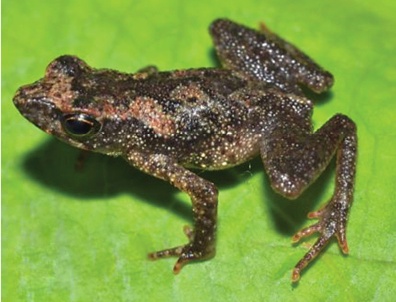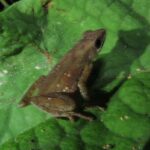- Amazophrynella minuta: Discovering the Tiny Jewel of the Amazon Forest Floor
- Taxonomy and Classification: Where Does <em>Amazophrynella minuta</em> Fit In?
- Natural Habitat: Hidden Treasures of the Amazon Rainforest Floor
- Physical Characteristics: Marvelous Miniatures of Adaptation
- Behavior and Life Cycle: Secret Lives in Rainforest Shadows
- Ecological Role: Guardians of Balance
- Threats and Conservation Status: Preserving an Elusive Treasure
- Cultural and Scientific Significance: Tiny but Mighty
- Conclusion: Championing the Tiny Ambassadors of Biodiversity
Amazophrynella minuta: Discovering the Tiny Jewel of the Amazon Forest Floor#
In the dense, humid heart of the Amazon rainforest—where towering trees draped in vines obscure the sun, and where countless mysteries still lie undiscovered—lives an incredible amphibian that easily goes unnoticed. Amid layers of leaves, moss, and shadows moves a tiny creature, so inconspicuous that its presence often slips past even the keenest observer. This minuscule marvel is Amazophrynella minuta, affectionately known among scientists as one of the smallest toads in the world. No larger than a thumbnail, this delicate amphibian reminds us of the amazing diversity hidden within Earth’s richest habitats, and equally of the importance of preserving such fragile species.
But don’t let its size fool you—while diminutive in stature, Amazophrynella minuta is big on ecological significance. A master of adaptation and disguise, its modest form is precisely what highlights its remarkable evolutionary journey. Join us on a fascinating exploration into the world of Amazophrynella minuta, where size is merely a disguise, and each discovery brings awareness about this elusive resident of Amazonian biodiversity.
Taxonomy and Classification: Where Does Amazophrynella minuta Fit In?#
Scientifically described as early as 1941 by renowned Brazilian herpetologist Antenor Leitão de Carvalho, Amazophrynella minuta belongs to the family Bufonidae, known commonly as the “true toads.” Within Bufonidae, it occupies the genus Amazophrynella, a relatively recent taxonomic grouping established to distinguish diminutive Amazonian species from their larger cousins. This genus comprises around a dozen described species, each adapted uniquely to their secretive rainforest niches.
Close relatives of Amazophrynella minuta, such as Amazophrynella bokermanni and Amazophrynella vote, share the small size and cryptic habits typical of the genus. However, minute variations in the morphology, vocalizations, and genetic composition place this species firmly into its own unique niche within one of the world’s most biodiverse amphibian families.
Natural Habitat: Hidden Treasures of the Amazon Rainforest Floor#
The stirring call of the Amazon resonates not only from its charismatic jaguars and colorful macaws but also from its subtler denizens. Venture into the moist embrace of the dense forest understory, amidst decaying leaves, twisted roots, and gentle trickling streams, and you’ll find the main stage for Amazophrynella minuta.
This species primarily inhabits the tropical forests of Peru, Ecuador, Bolivia, Colombia, Brazil, and parts of Venezuela. Though widespread geographically, its habitat preferences are strikingly specific; these tiny amphibians prefer the leaf-litter rich, moisture-retaining microhabitats on forest floors. Here, in the perpetual twilight beneath towering canopies, humidity remains high, temperatures consistent, and hiding places abundant—conditions essential for their delicate skin and secretive lives.
Microhabitat Specialists of the Leaf-litter#
Within these lush environments, they favor spots adjacent to small streams, shallow pools, or areas surrounding flooded forests during the rainy season. The presence of standing water is crucial for their reproductive cycle, serving as essential nurseries for their aquatic larvae, the tadpoles.
The leaf-litter floor provides hidden pathways and shelters from predators while facilitating the toad’s subtle but essential role in nutrient cycling. By maintaining steady microclimate conditions, these microhabitats allow survival in an otherwise challenging and competitive ecosystem, demonstrating nature’s powerful engineering abilities.
Physical Characteristics: Marvelous Miniatures of Adaptation#
Measuring merely 12-20 millimeters from the tips of their noses to the ends of their hind limbs, Amazophrynella minuta truly lives up to its name, “minuta,” which translates literally as “minute” or “tiny.” Their diminutive form makes them one of the smallest species amongst the “true toads,” sometimes no bigger than a fingernail.
Their coloration is subtle yet intricate, featuring shades of browns, greens, and greys that blend seamlessly with the surrounding detritus on the rainforest floor. Their skin exhibits a slightly roughened texture, covered sparsely with small bumps that aid further in camouflage by breaking up their visual outline, rendering them virtually invisible on the forest floor.
Adaptive Morphology for Survival#
Examining closely, a keen observer might notice slender limbs, perfect for climbing through dense leaf litter or hopping short distances between integumentary crevices. Eyes bold and slightly protruding grant wide peripheral vision, key to spotting predators and prey alike. Their toes, though unwebbed, are adeptly suited for their terrestrial lifestyle, enabling them to traverse the tangled rainforest understory with surprising agility.
Some populations of Amazophrynella minuta exhibit slight coloration variations depending on local conditions, providing evidence of evolutionary adaptation to their distinctly diverse rainforest microclimes.
Behavior and Life Cycle: Secret Lives in Rainforest Shadows#
Being predominantly nocturnal, Amazophrynella minuta emerges under cover of darkness to feed, mate, and communicate. By night, the air is thick with humidity, and the leaf-litter awakens to life as these miniature toads venture cautiously from their hidden retreats.
Feeding Habits and Predator Avoidance#
With opportunistic diets, they feed primarily on ants, tiny beetles, mites, and other small arthropods abundant amidst decomposing foliage. Employing precise, rapid movements, they expertly snatch prey with their sticky tongues, often without any discernible movement detectable to a human observer.
Predators include varied bird species, snakes, larger amphibians, and invertebrates like spiders and centipedes. Camouflage is their primary defense, relying principally on cryptic coloration to evade danger, sitting immobile, practically indistinguishable from surrounding debris.
Reproductive Cycle: From Delicate Tadpole to Tiny Terrestrial Toad#
Mating typically coincides with heavy rainfall, luring adults from hiding. Male frogs vocalize soft, insect-like calls from concealed positions to attract females. After brief courtship rituals, females deposit jelly-like eggs in shallow water or moist leaf-litter, where males fertilize them externally.
The developing tadpoles remain associated with temporary pools or flooded depressions, metamorphosing swiftly into tiny froglets capable of terrestrial survival. A typical clutch might produce dozens of offspring, but mortality rates in these early stages remain high due to predation and environmental vulnerability, emphasizing nature’s delicate balance.
Ecological Role: Guardians of Balance#
Despite—or perhaps because of—their minute stature, Amazophrynella minuta plays significant ecological roles. As insectivores, they regulate arthropod populations; as prey, they nourish larger predators, forming integral links within complex Amazonian food webs. Amphibians like this species often serve as bioindicators, their sensitive skins absorbing pollutants and environmental toxins, providing early warnings of ecological distress.
Threats and Conservation Status: Preserving an Elusive Treasure#
According to the International Union for Conservation of Nature (IUCN), Amazophrynella minuta is currently classified as Least Concern. Yet, like many amphibians worldwide, habitat disruption from deforestation, illegal logging, agriculture, and climate change potentially threatens its delicate survival mechanisms. The species’ dependence on very specific microhabitats magnifies susceptibility to even nuanced environmental changes.
Cultural and Scientific Significance: Tiny but Mighty#
Among indigenous Amazonian cultures, tiny amphibians can carry symbolic meanings relating to rain, fertility, and renewal. Scientifically, their unique biology has attracted researchers interested in biological adaptation, evolution, and the consequences of habitat fragmentation and deforestation.
Conclusion: Championing the Tiny Ambassadors of Biodiversity#
Introducing readers to Amazophrynella minuta serves not merely academic curiosity but broader environmental stewardship. These tiny amphibians, invisible to most eyes, whisper immense stories about evolution, ecology, and human responsibility towards Earth’s incredible biological wealth.
By learning about and supporting rainforest conservation initiatives, promoting environmental education, or even simply sharing knowledge about fascinating species such as Amazophrynella minuta, each of us can help ensure that these exceptional creatures continue thriving quietly amid the shadows and sunlight of their Amazonian homes. Tiny indeed, but emblematic of our need to appreciate and protect nature’s delicate beauty.















